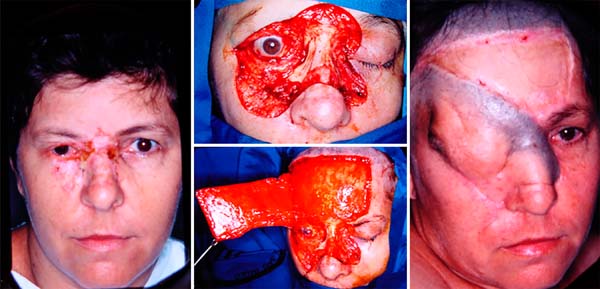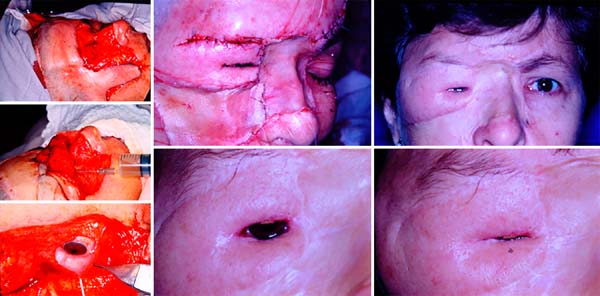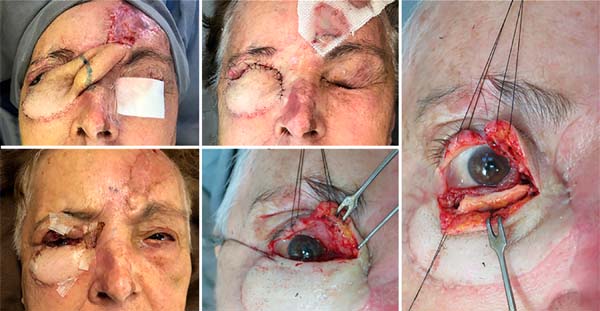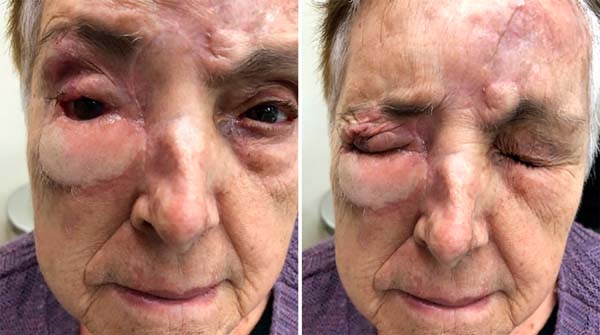INTRODUCTION
Eyelid reconstruction, after tumor resection, can be performed in different ways,
from more straightforward techniques such as primary closure and full-thickness
skin grafts to more elaborate and complex options, mainly local and locoregional
flaps. Regardless of the technique, the most important is to perform a
reconstruction that repairs the functions of all eyelid lamellae1,2.
In oncological reconstruction cases, advanced tumors generate more extensive
(more than one affected subunit) and deep skin resections, requiring the
combination of two or more flaps. Extensive and full-thickness eyelid resections
in cases of locally advanced malignant tumors may occur with enucleation or
exenteration of the eyeball due to the chance of involvement of the eyeball
and/or by reconstructive difficulty, and flaps are needed that allow only the
coverage of the defect created3,4.
Rare are the cases in which the resection of both eyelids’ total thickness (upper
and lower, medial and lateral corner) can preserve the eyeball3,4. In these situations, it is of fundamental importance to perform
immediate eyelid reconstruction, aiming primarily at maintaining their
functional capacity, since chronic malocclusions can lead to recurrent
keratitis, corneal ulcers, and eye loss. In the impossibility of a functional
reconstruction, with satisfactory opening and occlusion, the eyeball becomes
dispensable5.
The literature is scarce in the discussion of extensive eyelid resections with
preservation of the eyeball that describes reparations with local flaps that
allow, at the end of reconstruction, a satisfactory eyelid function6-8.
OBJECTIVE
The objective of this work is to report the experience of plastic surgeons of the
Orbitopalpebral Surgery Group (Division of Plastic Surgery and Burns of the
Hospital das Clínicas of the Faculty of Medicine of the University of São Paulo
- HCFMUSP) in cases of total or subtotal eyelid resection (upper and lower) in
total thickness with preservation of the eye globe.
METHODS
This was an observational, retrospective, and descriptive study, conducted after
approval by the( )research ethics committee of USP (CAPPesq) no.
2,876,023 at the outpatient clinic of the Orbitopalpebral Surgery Group of the
Division of Plastic Surgery and Burns of HCFMUSP. After tumor resection, all
eyelid reconstruction cases performed from 2000 to 2019 by this group were
reviewed.
Only cases of total or subtotal bipalpebral resection (upper and lower) with
resection of all lamellae and consequent to benign and/or malignant neoplasms
with preservation of the eyeball were included in this study.
Epidemiological, surgical, and postoperative follow-up data were collected. All
photographs present were previously authorized by the patients to be
published.
RESULTS
The team of arbitrary surgery of this hospital performs, on average, 1 to 2
surgeries/week of eyelid reconstruction after tumor exeresis. Among the more
than 1,400 cases of operated tumors, in these 20 years, two cases of bipalpebral
resection were identified and treated in total thickness with the possibility
of
preservation of the eyeball.
Case 1
A 54-year-old female patient presented ulcerated lesion in the upper and
lower right eyelid region, medial corner, glabella region, and nasal root,
as well as scar areas with tumor activity in the periphery in the left lower
eyelid and nasal dorsum, whose biopsy was shown to be sclerodermiform basal
cell carcinoma.
Complete resection of the lesion in monobloc with intraoperative freezing was
performed, resulting in an extensive defect of the entire upper and lower
eyelid region, including lateral and medial corner, glabella, and 2/3 upper
nose, keeping the eyeball intact.
For coverage of the entire bloody area, a temporofrontal cutaneous flap with
lateral pedicle to the right was used, based on the superficial temporal
artery and concomitant grafting of the donor area with partial-thickness
skin. This flap was positioned with its bloody area directly on the eyeball,
occluding the entire anterior face of the eyeball, as well as the
neighboring regions (Figure 1).
Figure 1 - A. Preoperative injury; B.
Intraoperative aspect with resection of the upper and lower
eyelid in total thickness, lateral and medial corner, in
addition to the nasal dorsum and medial corner of the left eye;
C. Pediculated temporofrontal flap on the right
to close the lesion; D. Postoperative aspect of 1
month, with tear bulging over the eye and skin grafting in the
donor area.
Figure 1 - A. Preoperative injury; B.
Intraoperative aspect with resection of the upper and lower
eyelid in total thickness, lateral and medial corner, in
addition to the nasal dorsum and medial corner of the left eye;
C. Pediculated temporofrontal flap on the right
to close the lesion; D. Postoperative aspect of 1
month, with tear bulging over the eye and skin grafting in the
donor area.
After four weeks, the patient evolved with bulging over the eye by tear
retention, which temporarily functioned as a tissue expander and was
punctured. This process was mentioned in other studies 6, which proposed maintaining small eyelid drainage
opening in a medial corner for its prevention5.
After four weeks, in a 2nd surgical time, the flap was repositioned in the
donor area previously grafted, keeping its deep part intact above the
eyeball. Thus, it resulted in a bloody area in the glabella, 2/3 upper nose,
and orbital region. Glabella, nasal dorsum and 1/3 middle of the left face
were submitted to new skin grafting, and the orbital region covered by a
flap of transposition of face, bipartite, and sutured to the neoconjunctiva
developed naturally (Figure 2). It is
noteworthy that, after the transverse opening of the thin layer on the eye,
it was found that it remained viable and without corneal ulceration (Figure 2). The flap’s inner face acquired
a macroscopic aspect identical to the normal conjunctiva, and later
preservation of normal visual function was observed.
Figure 2 - A. Second time, with repositioning of the flap
of the face; B. Lacrimal liquid collection
contained between the thin tissue and the eyeball;
C. Opening of the palpebral cleft, with
exposure of the iris and pupil region; D. Opening
of a cleft in the temporofacial flap and grafting of the other
areas; E. Postoperative period of 12 months, with
the opening of a cleft in the flap; F and
G. Opening and closing of the
neoeyelid.
Figure 2 - A. Second time, with repositioning of the flap
of the face; B. Lacrimal liquid collection
contained between the thin tissue and the eyeball;
C. Opening of the palpebral cleft, with
exposure of the iris and pupil region; D. Opening
of a cleft in the temporofacial flap and grafting of the other
areas; E. Postoperative period of 12 months, with
the opening of a cleft in the flap; F and
G. Opening and closing of the
neoeyelid.
After three months, the patient was able to perform only partial occlusion
movements. On this occasion, the surgery proposed by Gilles was performed
with temporal fascia to improve eyelid closure. The eyelid opening was
obtained after another three months, through a frontal suspension, with
silicone eyelid suspension, thus ensuring a greater field of view. The flap
was also indicated, but the patient refused to undergo the procedure. She
was followed for two years in the outpatient clinic without complications of
surgery.
Case 2
An 80-year-old female patient presented recurrence of basal cell carcinoma
operated for seven years, showing hyperemia lesion, nodulations,
telangiectasias, and pearly edges, which affect 2/3 of the upper eyelid and
the entirety of the lower right, medial corner, and part of the lateral
corner. Besides, he also had scars from multiple previous surgeries with
basal cell carcinoma recurrences.
Complete resection of the lesion was performed, with free surgical margins
after an intraoperative freezing examination. The resulting defect consisted
of the total absence of medial and lateral corner, lower eyelid, and 80% of
the upper eyelid. In this case, there was also no need for enucleation or
exenteration.
The reconstructive option that would allow immediate eyeball protection and
partial restoration of eyelid function in the future was the midfrontal
flap, which was planned for reconstruction in 4 surgical times:
First time: demarcation was performed, the midfrontal flap was surveyed based
on the left supratroclear artery (with thinner thickness in the 2/3 distal)
and transposition of the same on the defect created. Only 20% of the upper
eyelid in its lateral part was spared. Thus, the flap was sutured to the
residual upper eyelid and periorbital region, completely covering the
eyeball without any conjunctival lining. The donor area was recovered at the
expense of partially thick skin grafts (Figure 3).
Figure 3 - A. Right periorbital lesion; B.
Intraoperative aspect with subtotal resection of the upper
eyelid saving 20% of upper eyelid laterally and a total of the
lower, lateral, and medial corner; C. Pediculated
frontal flap demarcation on the left for the closing of the
bloody area; D. Flap rotation, with positioning and
points of adoption in the medial corner; E. Total
closure on the eyeball and grafting in the donor area;
F. Aspect in the immediate postoperative period
with skin grafting and Brown dressing in the donor area.
Figure 3 - A. Right periorbital lesion; B.
Intraoperative aspect with subtotal resection of the upper
eyelid saving 20% of upper eyelid laterally and a total of the
lower, lateral, and medial corner; C. Pediculated
frontal flap demarcation on the left for the closing of the
bloody area; D. Flap rotation, with positioning and
points of adoption in the medial corner; E. Total
closure on the eyeball and grafting in the donor area;
F. Aspect in the immediate postoperative period
with skin grafting and Brown dressing in the donor area.
Second time: performed after 21 days, consisting of the pedicle section at
the level of the medial corner, returning part of it to the donor area. The
flap’s medial edge, already separated from the pedicle, was sutured to the
defect’s medial face (Figure 4).
Figure 4 - A. Demarcation for release of the flap pedicle;
B. Immediate postoperative period after pedicle
release; C. Immediate postoperative period, after
opening the eyelid cleft in the 3rd time; D and
E. Store dissection and placement of the scaly
cartilage graft in the upper and lower eyelid.
Figure 4 - A. Demarcation for release of the flap pedicle;
B. Immediate postoperative period after pedicle
release; C. Immediate postoperative period, after
opening the eyelid cleft in the 3rd time; D and
E. Store dissection and placement of the scaly
cartilage graft in the upper and lower eyelid.
Third time: after 21 days, the patient underwent a new procedure, which
consisted of partially incising the flap already autonomized, recreating the
palpebral cleft. After 21 days, the patient underwent a new procedure, which
consisted of partially incising the flap already autonomous, recreating the
eyelid cleft. The intact eyeball and neoformed conjunctiva were identified
on the flap’s internal face in contact with the globe (Figure 4). There was a process of neoformation of
conjunctival tissue over subcutaneous cellular tissue, similar to cartilage
grafting, as seen in some studies9,10.
Fourth time: after three weeks, flap slimming and auricular scathing
cartilage grafting on the upper and lower eyelid scans were performed,
aiming at aesthetic and functional improvement (Figure 4). The patient evolved with good eyelid opening
and closure at the expense of the remnant of the upper eyelid lifter muscle
(Figure 5).
Figure 5 - A and B. Postoperative period of 6
months, with eyelid opening and closure.
Figure 5 - A and B. Postoperative period of 6
months, with eyelid opening and closure.
DISCUSSION
Full-thickness uni-eyelid defects can be treated with excellent aesthetic and
functional results through the use of local flaps, including the use of
contralateral eyelid tissue7. On the other
hand, full-thickness bipalpebral defects are challenging for the reconstructive
surgeon due to the area’s size to be reconstructed and the scarcity of adjacent
tissue sufficient to cover it, mainly when previous surgeries have already been
performed on site5,7. Situations in which all or most of the
orbital region is resected and the eyeball is preserved are rare, usually
secondary to tumor burns, traumas, or excisions5.
The primary goal of reconstruction is to protect and maintain eye function since
chronic exposure can lead to recurrent keratitis, corneal ulcer, and,
eventually, even blindness. Thus, reconstructive procedures should be used to
obtain occlusion and eyeball protection immediately after the eyelid lesion.
On
the other hand, restoring eyelid functionality with sufficient mobility,
allowing opening and eyelid occlusion within each case’s limitation, is
fundamental. Facial symmetry and social reintegration are important objectives
but not always achieved1,2,11.
There are few options described in the literature for this complex
reconstruction, but they are usually based on individual reconstructions of the
anterior and posterior lamella5. This
article describes their total thickness bipalpebral reconstruction experience
with regional flaps, associating auricular cartilage grafting in the 2nd case.
With the proposed surgery, the procedure’s technical difficulty is reduced, and
donor areas of conjunctiva graft are spared, without prejudice to the eyeball.
With the direct coverage of the flap’s eye, the process of neoformation of
connective tissue occurs on the subcutaneous cellular tissue and acquires a
conjunctival aspect11,12.
In addition to the advantages mentioned, the final result has a lower total
thickness, although it is still necessary to lose weight to improve eyelid
mobility. Another factor contributing to the maintenance of eyelid function,
available only in case 2, is the remnant of the upper eyelid liftmuscle7. In some cases, resection of the eyelid
tissue is almost complete. However, when still partially present, the upper
eyelid lift muscle can guarantee upper eyelid functionality, as seen in case
2.
Total reconstruction in the upper and lower eyelids using a frontal flap of
varied characteristics usually leaves the reconstructed area with significant
thickness and stiffness. Eyelid movement is extremely restricted due to subtotal
or total resection of the lifter, and occlusion is compromised by complete
resection of the orbicularis muscle. The literature suggests a tendency of
thick, rigid, and immobile eyelids after the new eyelid cleft5, but such aspects were not observed in the
reported cases.
In total eyelid reconstructions using a frontal, frontotemporal flap or
“masquerade graft” technique, it is always imperative to maintain a 3mm orifice
for lacrimal drainage avoiding tear accumulation or cysts that can generate
infectious processes. This opening, usually in the nasal corner, is also
essential for irrigation and mechanical cleaning of the eyes in this surgical
phase10,13. However, in the cases presented, we
could keep the globe occluded, and the tear accumulation served as protection
for the eyeball.
Concerning the definition of the new eyelid cleft position, it should be
programmed with an awake patient and in orthostasis7. Reconstitution of the palpebral cleft late does not cause
any structural damage to the eyeball, only temporary obstruction of vision. One
of the most significant advantages observed in using a single flap, as in the
cases described, is occlusion and protection of the eyeball while the flap
autonomization occurs. The literature cases that report reconstruction with
independent flaps for the upper and lower eyelid present a higher rate of
keratopathies by corneal exposure5.
CONCLUSION
After bipalpebral resection with preservation of the eyeball, we suggest a new
reconstruction option based on a single flap and the neoformation of connective
tissue, providing protection and conservation of the eyeball during the
different surgery stages. The results were functionally favorable, considering
the severity of the cases.
REFERENCES
1. Mustardé JC. Reconstruction of eyelids. Ann Plast Surg.
1983;11:149-69.
2. Codner MA, McCord CD, Mejia JD, Lalonde D. Upper and lower eyelid
reconstruction. Plast Reconstr Surg. 2010 Nov;126(5):231e-45e. DOI: https://doi.org/10.1097/PRS.0b013e3181eff70e
3. Alghoul M, Pacella SJ, McClellan WT, Codner MA. Eyelid
reconstruction. Plast Reconstr Surg. 2013 Ago;132(2):288e-302e. DOI: https://doi.org/10.1097/PRS.0b013e3182958e6b
4. DiFrancesco LM, Codner MA, McCord CD. Upper eyelid reconstruction.
Plast Reconstr Surg. 2004 Dez;114(7):98e-107e. DOI: https://doi.org/10.1097/01.PRS.0000142743.57711.48
5. Sousa JL, Leibovitch I, Malhotra R, O'Donnell B, Sullivan R, Selva
D. Techniques and outcomes of total upper and lower eyelid reconstruction. Arch
Ophthalmol. 2007 Dez;125(12):1601-9.
6. Badilla J, González-Arias S. Scalping forehead transposition flap
for total eyelid reconstruction with periocular involvement associated with a
conjunctival cyst formation. Int J Orbital Disord Oculoplastic Lacrimal Surg.
2014;33(3):206-9. DOI: https://doi.org/10.3109/01676830.2013.859278
7. Bertrand B, Colson Junior TR, Baptista C, Georgiou C, Philandrianos
C, Degardin N, et al. Total upper and lower eyelid reconstruction: a rare
procedure-a report of two cases. Plast Reconstr Surg. 2015 Out;136(4):855-9.
DOI: https://doi.org/10.1097/PRS.0000000000001600
8. Lalonde DH, Osei-Tutu KB. Functional reconstruction of unilateral,
subtotal, full-thickness upper and lower eyelid defects with a single hard
palate graft covered with advancement orbicularis myocutaneous flaps. Plast
Reconstr Surg. 2005 Mai;115(6):1696-700. DOI: https://doi.org/10.1097/01.PRS.0000161455.07552.48
9. Converse JC, Smith B. Repair of severe burn ectropion of the eyelid.
Plast Reconstr Surg Transplant Bull. 1959 Jan;23(1):21-6.
10. Snyder GB, Edgerton MT. Masquerade graft technique for simultaneous
reconstruction of the upper and lower lids in patients with blastomicosis,
amyloidosis or other chronic septic destructive lesions. Plast Reconstr Surg.
1964 Ago;34:163-8.
11. Friedhofer H, Salles AG, Jucá MCCR, Ferreira MC. Eyelid
reconstruction using cartilage grafts from auricular scapha. Eur J Plast Surg.
1999;22(2-3):96-101.
12. Nigro MVAS, Friedhofer H, Natalino RJM, Ferreira MC. Comparative
analysis of the influence of perichondrium on conjunctival epithelialization
on
conchal cartilage grafts in eyelid reconstruction: experimental study in
rabbits. Plast Reconstr Surg. 2009 Jan;123(1):55-63. DOI: https://doi.org/10.1097/PRS.0b013e3181904b6d
13. O'Reilly P, Malhotra R. Our experience with the masquerade procedure
for total eyelid loss. Orbit. 2010 Dez;29(6):1313-6.
1. Hospital das Clínicas, Faculty of Medicine,
University of São Paulo, Department of Plastic Surgery and Burns, São Paulo,
SP,
Brazil.
2. Private Practice, Plastic Surgery, São Paulo,
SP, Brazil.
*Corresponding author: Rodolfo Costa Lobato Rua Melo
Alves, 55, Conjunto 23, Cerqueira César, São Paulo, SP, Brazil. Zip Code:
01417-010 E-mail: rodolfolobato49@yahoo.com.br
Article received: July 06, 2020.
Article accepted: July 23, 2020.
Conflicts of interest: none


















